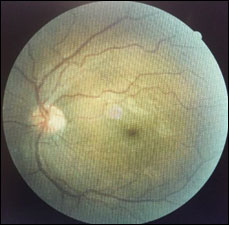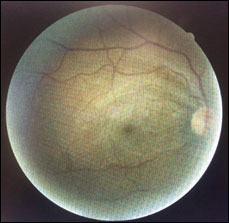Proliferative diabetic retinopathy revealed using OCT angiography
Diabetic retinopathy is one of the leading causes of vision loss worldwide. Uncontrolled blood glucose levels damage retinal vasculature. Anyone with diabetes is at risk for diabetic eye disease, but the risk increases with a longer duration of the disease, higher levels of hyperglycemia, hypertension, obesity and genetics. Therefore, it is of utmost importance to examine the retinal arterioles and venules thoroughly and detect change early.
OCT angiography (OCT-A) is new technology that provides a noninvasive imaging method that can allow clinicians to detect diabetic changes in vasculature prior to the onset of observable manifestations of diabetic retinopathy (DR) using traditional methods. This is referred to as “subclinical” retinal disease. OCT-A utilizes the theory of motion contrast, depicting different reflectance patterns over time based on the flow of red blood cells within the vasculature. Hence, OCT-A can reveal vascular abnormalities such as microaneurysms, intraretinal microvascular abnormalities (IRMA) and neovascularization, perhaps even before it is funduscopically detectable.

Case report
A 35-year-old white man presented to the clinic in October 2017 with a history of systemic hypertension and type 2 diabetes mellitus (DM) with previous episodes of poor glycemic control. He was diagnosed with DM in February 2017 and has a current blood sugar of 125 mg/dL and HbA1C of 6.2%. Blood pressure was within normal limits.

Best corrected visual acuities (BCVA) were 20/25+2 OD and 20/30+1 OS. Pupils were equal, round and reactive to light without relative afferent pupillary defect, and confrontation visual field testing was full to finger counting in each eye. Anterior examination showed 1+ nuclear sclerotic cataract in both eyes, and IOPs were 15 mm Hg OD and OS. Dilated fundus exam revealed microaneurysms in the macula without edema, dot/blot hemorrhages in all four quadrants of the posterior pole that extended to the periphery, venous beading, IRMA along the inferior nasal and inferior temporal arcades, few flame hemorrhages, a fresh vitreous hemorrhage settled in all inferior quadrants and posterior vitreous detachment (PVD) in the right eye. The left eye showed microaneurysms in the macula with clinically significant macular edema, dot/blot hemorrhages in all four quadrants of the posterior pole that extended to the periphery, IRMA along the inferior nasal arcade and PVD.

The patient was diagnosed with proliferative diabetic retinopathy (PDR) in both eyes with central serous macular edema (CSME) in the left eye and was referred to a retinal specialist for further evaluation and management.
Five days later the patient returned to the clinic for a diabetic retinal examination with an optometric retinal specialist. At this visit, blood sugar was noted at 102 mg/dL, and HbA1C was 6.2%. BCVA was 20/25-1 OD and 20/40-2 OS. Dilated fundus exam revealed similar funduscopic findings in each eye. OCT-A scans revealed neovascularization of the disc (NVD) at the superior rim approximately 1/20 disc diameter in size, which was previously undetected with 90-D ophthalmoscopy.


The patient was diagnosed with high-risk PDR with vitreous hemorrhage in the right eye and severe nonproliferative diabetic retinopathy (NPDR) with CSME in the left eye. He was educated on the importance of tight blood pressure and glucose control and adherence to medications and doctor visits, with an emphasis on healthy diet and exercise. The patient was referred for intravitreal injection of bevacizumab in the right eye and would be closely monitored for CSME in the left eye.

The patient successfully completed the injection in the right eye without complications and returned for his 1-week follow up in November. BCVA was 20/25 OD and 20/40 OS. OCT-A scans confirmed complete resolution of NVD in the right eye, and OCT of the retina showed partial resolution of CSME in the left eye. Dot/blot hemorrhages were still present in both eyes. The importance of tight blood pressure and glucose control was reinforced. He was scheduled to return to clinic for his 1-month post-op visit.
Discussion
The differential diagnoses for DR include but are not limited to: central retinal vein occlusion, branch retinal vein occlusion, ocular ischemic syndrome, hypertensive retinopathy or radiation retinopathy, sickle cell retinopathy, sarcoidosis and ocular ischemic syndrome. The work-up for a diabetic eye exam includes a slit lamp examination with gonioscopy and a dilated fundus examination. Intravitreal fluorescein angiography (IVFA) is also warranted to detect any abnormalities within the retinal vasculature such as microaneurysms, hemorrhages, IRMA, ischemia and areas of neovascularization. OCT-A is not a replacement for IVFA, but it is a great supplementary tool.
OCT-A is a noninvasive method to meticulously assess the retinal vasculature. It is based on motion contrast by utilizing the movement of red blood cells within the tissue, which results in different reflectance patterns over time. Four consecutive images are taken at each retinal location and then analyzed by the software for any differences. This is referred to as the “decorrelation signal.” A higher decorrelation signal denotes faster blood flow and appears brighter on the OCT-A images. However, blood cells that are flowing too fast or too slow will show undetectable reflectance changes that are not capable of being imaged. Slower blood flow correlates to late-stage hyperfluorescence, so OCT-A cannot image patterns such as leakage, pooling or staining that can be imaged on IVFA.
OCT-A is capable of detecting “subclinical” diabetic retinal disease by assessing for enlargement of the foveal avascular zone, which suggests macular ischemia, and areas of capillary nonperfusion, which promotes the release of vascular endothelial growth factor. It can also differentiate between NVD/neovascularization elsewhere and IRMA. Any preretinal neovascularization will be appear as a bright signal in the vitreoretinal interface (VRI) angiogram, whereas IRMA will not due to its location within the retina. Areas of neovascularization can be accurately measured, allowing clinicians to precisely monitor the condition and definitively evaluate for any progression or regression after treatment.
Six en face OCT angiograms are typically imaged as follows from most anterior to posterior: VRI, superficial retina, deep retina, retinal pigment epithelium (RPE), choriocapillaris and tissue behind the choriocapillaris. The VRI gives information from the internal limiting membrane to 300 µm into the vitreous. In a healthy eye, the VRI has no vascular movement, so it should be void of signal. This layer is useful in detecting preretinal neovascularization. The superficial retina angiogram visualizes vasculature in the nerve fiber layer, ganglion cell layer and inner plexiform layer while the deep retina angiogram visualizes the inner nuclear layer and outer plexiform layer. The next angiogram includes data from the photoreceptors and RPE. Both structures are avascular, so will also be void of signal in a healthy eye. The choriocapillaris angiogram represents a 20-µm thick section of tissue right below the RPE. Lastly, the sixth angiogram images the choroid by visualizing a 50-µm thick section of tissue beneath the choriocapillaris. It will look dark due to fast flow and depth of the tissue.
Both DM and DR are affecting more of the population and becoming a great concern. OCT-A is an extremely useful tool that provides a quick, noninvasive method to help detect “subclinical” DR and offer these patients the best care possible.
- References:
- CDC. Estimates of diabetes and its burden in the United States. National Diabetes Statistics Report. https://www.cdc.gov/diabetes/pdfs/data/statistics/national-diabetes-statistics-report.pdf. Posted 2017. Accessed June 13, 2018.
- CDC. New CDC report: More than 100 million Americans have diabetes or prediabetes. https://www.cdc.gov/media/releases/2017/p0718-diabetes-report.html. Posted Dec. 18, 2017. Accessed June 13, 2018.
- Ehlers JP, Shah CP. The Wills Eye Manual: Office and Emergency Room Diagnosis and Treatment of Eye Disease, 5th ed. Philadelphia: Lippincott Williams & Wilkins.
- Forouhi, NG, et al. Medicine. 2014;doi:10.1016/j.mpmed.2014.09.007.
- Majcher C, et al. Review of Optometry. March 15, 2017. www.reviewofoptometry.com/article/imaging-motion-a-review-of-octa.
- National Eye Institute. Facts About Diabetic Eye Disease. https://nei.nih.gov/health/diabetic/retinopathy. Reviewed September 2015. Accessed June 13, 2018.
- For more information:
- Alpana Scantlin, OD, is a primary care/ocular disease resident at the University of the Incarnate Word Rosenberg School of Optometry. She can be reached at kumar@uiwtx.edu.
Disclosure: Scantlin reported no relevant financial disclosures.
